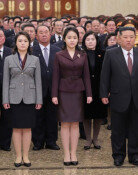[Opinion] Telling Fetuses Gender
[Opinion] Telling Fetuses Gender
Posted August. 01, 2008 03:29,
No country in the world will have more theories that help tell the gender of unborn babies than Korea. If a pregnant womans belly shapes like a ball, it means the fetus is a girl and, if not, it suggests a boy. When an expectant mother suffers morning sickness in the morning, she will probably deliver a girl baby, and when she suffers the symptom in the evening, on the contrary, the fetus is a boy. When the first child goes into his or her moms arm facing her, the child will have a sister, and the first child does so showing her the back, he or she will have a brother. A silver spoon in the dream of forthcoming conception indicates a boy, while a shelled chestnut means a girl. And the theories go on and on. This testifies how eagerly Koreans want to know their unborn babys gender.
Although fetuses gender can be found out with a simple test these days, quite a few parents still turn to those unscientific explanations. That is because the gender test of fetuses became illegal in 1987. When found to have violated the law, physicians face suspension of their licenses. Expectant parents, who have no clue to their babies gender, have problems from making names to purchasing baby items. In ob-gyn hospitals, one can witness interesting scenes that might never be seen in other countries. It is only in Korea that expecting families shout in joy when a nurse finally informs them of the gender of their newborn baby.
The Constitutional Court ruled yesterday that the medical law banning fetuses gender test is unconstitutional. The court has determined that the ban runs counter to the changes of the times where birth rates are falling and gender equality is improving, and that it infringes on physicians right to pursue their career and also pregnant womens right to know. Korea, along with China, has remained the only countries in the world that forbid gender tests of unborn babies. Both countries have traditionally strong preferences to boys. Some point out that the existence of the ban shows the backwardness of our culture and Korean peoples perception.
The nations gender ratio is recovering its balance due to plummeting birth rates. In 1996, the ratio of girls to boys was 100:116.6. Ten years later in 2006, however, the ratio became 100 to 107.4, almost reaching the natural gender ratio of 100 to 103-107. Still, a sizable number of people say its too early to repeal the clause. They base their argument on the fact that the birth rate of the third child is still higher because of parents who want to have a boy and that Korea ranks top or second in the world in terms of abortion rates. Yet they should notice how rapidly things are changing. People now predict that the abolition of the clause in question would bring more abortions of male fetuses than those of female fetuses.
Editorial Writer Chung Seong-hee (shchung@donga.com)




![전기매트 틀고 자면 몸에 전자파 쌓인다?” 직접 측정해보니 [알쓸톡]](https://dimg.donga.com/c/138/175/90/1/wps/NEWS/IMAGE/2026/01/02/133079758.3.jpg)

![금수산 참배 사진, 김주애의 위치가 말하려는 것[청계천 옆 사진관]](https://dimg.donga.com/c/138/175/90/1/wps/NEWS/IMAGE/2026/01/02/133079009.1.jpg)
